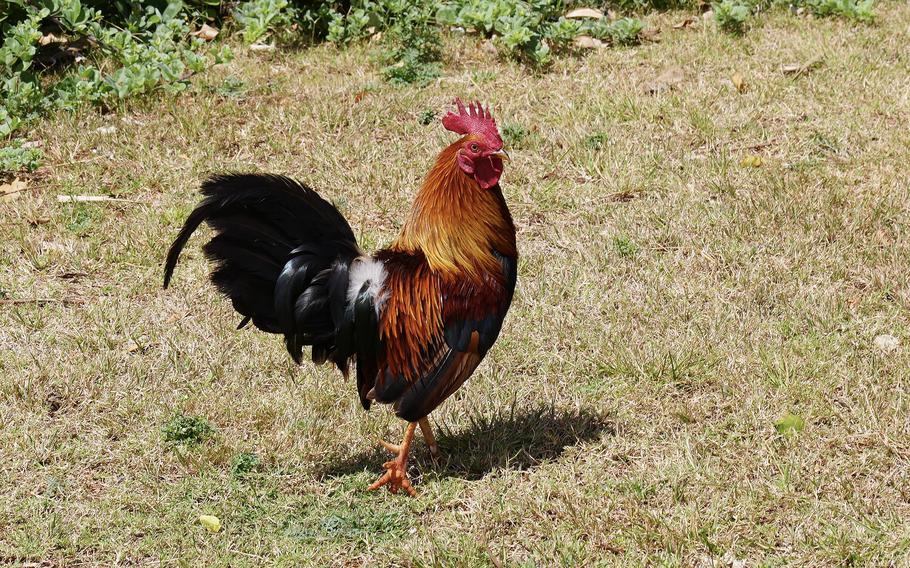
A feral chicken on Kauai, Hawaii. Hawaii has a feral chicken problem — and it’s being discussed everywhere from city councils to the state legislature. (Richard N Horne/Wikimedia Commons)
The cock-a-doodle-doos ring from dusk ‘til dawn. Plants are pecked, vegetable gardens depleted and yards dug up with holes. Droppings surround houses and streets where the fowl intruders are making neighbors plead for an end to the torment.
Hawaii has a feral chicken problem — and it’s being discussed everywhere from city councils to the state legislature.
“We receive so many emails and phone calls from all over the state, not just in our district,” Hawaii state Sen. Bennette Misalucha told The Washington Post.
Feral chickens, which are not native to Hawaii, have become a bit of a fixture on the islands of Oahu and Kauai. Their presence is reflected in dashboard dolls, magnets and other touristy trinkets. But their mushrooming population — in some places, reaching the thousands — has left neighbors begging for an end to the birds’ earsplitting shrieks.
During a Honolulu City Council meeting last week, the city revealed that it had spent almost $7,000 to set traps in five areas. Yet, with only 67 chickens caught, the cost for trapping each bird was about $104 — something the city’s Department of Customer Services Director Kimberly Hashiro said the agency was hoping to bring down while also expanding the program to other areas.
“There needs to be more time really spent to find appropriate locations and to see how effective the funds being spent are,” Hashiro said in the meeting. “We’ve gotten a lot of feedback from the community that is quite divided. It is, you know, between ‘leave the chickens alone’ to ‘it’s about time’ to ‘do we really need to spend funds on this?’”
The feral chickens have deep roots in Hawaii. Local lore posits they’re the product of Hurricane Iniki’s destruction in 1992, which knocked down coops and released chickens into the wild. According to a 2015 study, they appear to be descendants of the ancestral red junglefowl the Polynesians brought to the island over 800 years ago that then mated with escaped chickens.
But their number has grown significantly these past years, residents say, and managing their pesky antics has become an impossible task.
“I have lived in Pacific Palisades for 34 years and observed the uncontrolled proliferation of feral chickens in my neighborhood as well as throughout the Pearl City residential and business establishments,” one resident wrote in a testimony to the state senate. “The crowing begins at sunrise and continues throughout the day until dusk...Our once quiet and peaceful neighborhood is deteriorating.”
“In recent years, due to the infestation of feral chickens it has become impossible to grow vegetables or food crops,” another resident testified. “The large numbers of feral chickens eat the seeds as soon as they are sowed and any of the plants that start to grow. All efforts at fencing/netting etc. have proven impractical.”
Who responds to complaints depends on where the chickens are located. State agencies respond to reports of birds at public schools or state parks. When it comes to homes, there’s not much officials can do, except recommend that residents file a complaint with the city council or contact a wildlife-removal service.
The lack of solutions prompted Misalucha, the state senator, to draft a bill seeking a five-year study to determine the best way to manage the booming feral chicken population. The proposed bill, she said, offered studying solutions that are “cost-effective and humane” — for instance, prescribing OvoControl, a contraceptive bait found to be effective in controlling pigeon populations.
Misalucha initially made a bid for the study to be conducted in her district on Oahu. But it was later proposed as a statewide measure after the senate’s committee on health was flooded with complaints about the chickens.
Testimony submitted to the state Senate showed widespread support for the bill. One woman said she was “pleading with you all to pass this bill because I don’t know how many more sleepless nights I can take!”
Ultimately, however, the bill “died a natural death” after it passed to the House, Misalucha said.
“But we still have the same issues,” she said. “And I think between the state and city, we’re both trying to wrestle with the same problem.”
The Hawaii state legislature has already adjourned this year, so any new bills on the issue would have to be introduced next year when the regular session convenes. Until then, residents in feral chicken-infused communities will have to grapple with what one called an “almost indescribable” nuisance.
“The rooster crowing is not the Old McDonald Nursery rhyme; it is high pitch scream like yell at times at all different octaves and sound levels,” one resident testified.